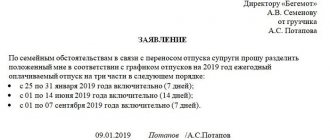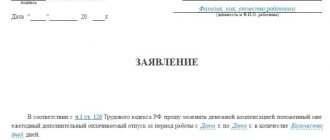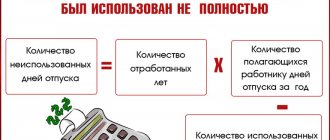Each employee has the right to annual paid leave of at least 28 calendar days (Article 155 of the Labor Code). The head of the enterprise can increase this period by fixing the changes in a collective agreement or internal regulations (Article 120 of the Labor Code), while any reduction in the minimum duration of rest will be unlawful.
The legislation also provides for the possibility of using the vacation period not immediately, but in parts, at different times of the year. How vacation can be divided according to the Labor Code depends solely on the wishes of the employee. The need for this may arise on the initiative of:
- An employee who, due to family circumstances or for other reasons, wishes to take part of the vacation at a certain time.
- A manager who is experiencing a constant shortage of employees or needs to mobilize them to resolve a difficult production situation.
The manager does not have the right to interfere with the employee’s desire to share vacation at his own discretion, while the same actions on the part of the management themselves require the obligatory consent of the employee.
How many parts can a vacation be divided into?
When dividing vacation, you cannot violate the rule established by Art. 125 of the Labor Code and corresponding to the requirements of the International Labor Organization Convention No. 132 of September 6, 2011. Specifically, the duration of at least one part of it should not be less than 14 calendar days. Whether it is possible to divide vacation by day is not determined by the Labor Code. Theoretically, the second half of the vacation can be divided into arbitrarily small periods, even consisting of one day.
These actions will not contradict the law, although they will certainly meet some resistance from management. In addition, calculating benefits for too short a period of rest is also somewhat more difficult. For the employee himself, going on vacation for such short intervals cannot be considered as receiving proper rest.
When planning to divide his vacation into parts, the employee must clearly know how many days of vacation he is entitled to this year, and how he can break down his vacation. After all, perhaps he has been working for less than a year, and his vacation will be less than 28 days. Or he has special privileges and a longer vacation, or maybe the employee has vacation left over from the previous period. Find out how to calculate the number of vacation days in each specific case here.
Rest on weekdays
There are different ways in which vacation can be divided according to the Labor Code. It can be divided into parts that include both working days and weekends. However, the employee has the right to apply for rest within five working days. Taking into account the previous and subsequent days off, he thereby extends his vacation by four days.
In fact, the employee rests for nine days, of which five are paid - included in the vacation. By applying this splitting system to the entire fourteen-day period allowed for splitting, the employee can increase the total duration of leave by ten days. Of course, vacation pay will be accrued only for 28 calendar days.
Vacation only on weekends
It makes no sense for an employee to take a vacation on weekends, since he would have rested on these days without it. Nevertheless, such situations are beneficial for the employer, which is why they occur in enterprises. In other words, the employee is provided with mandatory 14 days of undivided vacation, after which the remainder is distributed on Saturdays and Sundays - resulting in seven segments of two days.
Thus, the employer has a full staff of employees who practically do not go on vacation.
The only difference is that wages are accrued for days off that fall during vacation periods. From a formal point of view, such a division of annual paid leave into parts does not violate the norms of the Labor Code, but is still illegal even with the voluntary consent of the employee. Since the employee has the right to a vacation of 28 days (Article 21 of the Labor Code; Part 5 of Article 37 of the Constitution), which will not be implemented under the described scheme. Its constant use may provoke an inspection by the Labor Inspectorate and the imposition of penalties. It is worth noting: employees often plan activities for vacation that can only be done on a weekday (for example, going to the dentist). If the employer does not agree to provide the employee with leave on weekdays and insists on rest only on weekends, then the employee can write an application for time off with the wording “I ask you to provide me with time off for vacation” and indicating a valid reason for his future absence.
Splitting additional leave
Additional leave is provided for work in difficult and harmful working conditions and, in combination with the main one, exceeds the required 28 days (Article 115 of the Labor Code). Read about the provision of additional leave for hazardous working conditions in 2021 in the article https://otdelkadrov.online/11044-raschet-predostavlenie-otpuska-za-vrednye-usloviya-truda-po-tk-rf. It can also be divided into smaller segments, although this is not directly stated in the legislation. An indirect solution to this can be considered the possibility of replacing additional leave with monetary compensation (Article 127 of the Labor Code).
Review from vacation
Calling an employee to work before the end of vacation in case of production necessity is possible only with his consent (Part 2 of Article 125 of the Labor Code). He can use the remaining part of the vacation at any time of the year at his own choice or add it to the next vacation, which decision is reflected in the issued order. An employee’s refusal to comply with the demands of his superiors cannot be equated to a violation of labor discipline (clause 37 of the Post. Plenum of the Supreme Court No. 2 of March 17, 2004). Find out here in what cases an employee can be recalled from vacation.
If an employee has already used 14 days of rest, dividing them into parts, it is unlawful to recall him from the remaining half of the vacation. Also, even with consent, it is prohibited to interrupt employees’ rest:
- under 18 years of age;
- pregnant women;
- working in difficult and dangerous conditions.
Next in the video about dividing annual paid leave into parts
Commentary on Article 125 of the Labor Code of the Russian Federation
By agreement between the employee and the employer, annual paid leave can be divided into parts. Moreover, at least one part of this leave must be at least 14 calendar days (Article 125 of the Labor Code of the Russian Federation).
Expert opinion
Lebedev Sergey Fedorovich
Practitioner lawyer with 7 years of experience. Specialization: civil law. Extensive experience in defense in court.
Recall of an employee from vacation is permitted only with his consent. The part of the vacation not used in this regard must be provided at the employee’s choice at a time convenient for him during the current working year or added to the vacation for the next working year.
Recall from vacation is not allowed:
1) employees under 18 years of age;
2) pregnant women;
3) workers engaged in work with harmful or dangerous working conditions.
Annual paid leave must be extended in cases where:
1) the employee fell ill during vacation;
2) the employee performed government duties during the vacation (if the law provides for exemption from work);
3) in other cases provided for by law or local regulations of the organization.
Annual paid leave by agreement between the employee and the employer is transferred to another period if the employee was not paid in a timely manner during this leave or the employee was notified about the start time of the leave less than two weeks before it began.
In exceptional cases, when the provision of leave to an employee in the current working year may adversely affect the normal course of work of the organization, it is allowed, with the consent of the employee, to transfer the leave to the next working year. In this case, the leave must be used no later than 12 months after the end of the working year for which it is granted.
Decor
The division of vacation according to the Labor Code is based on:
Payment for parts of vacation
Vacation pay is calculated depending on the employee’s application. If it is written from Monday to Sunday, then the employer will pay vacation pay for 7 days. When the application is written from Monday to Friday, the employee will receive vacation pay only for these days, but will actually rest for the same seven days. If the application is written for Saturday-Sunday, then the employee will receive vacation pay for two days off, which he would have taken off in any case.
- Vacation schedule for the next year, which includes the dates of all components of the vacation. This document is presented to employees for review and approval, the fact of which is confirmed by their signatures.
- Written statement from the employee. This option is appropriate in companies with a small staff, as well as in the case of splitting vacations after the vacation schedule for the next year has been approved.
The second option requires some additional steps:
- The director's decision is indicated in the corner of the application.
- An order on the division of leave is issued (form T-6), certified by the signature of the manager and the seal of the organization. The information contained in it is identical to that specified in the application.
- The accountant fills out a calculation note (form T-60) to calculate vacation pay.
- Information regarding leave is entered into the employee’s personal card.
- The data in the time sheet that takes into account work time is subject to change.
- New dates are noted in the vacation schedule, and the reason and date of changes are entered in the vacation transfer column.
Statement
The vacation breakdown application must contain:
- name and address of the organization;
- Full name of the applicant;
- the essence of the request, preferably with an explanation of the reasons, which will increase the likelihood of a positive decision;
- desired dates for going on vacation and its completion;
- date of application;
- employee signature.
In what parts can you take annual leave?
In this case, in the line “for the period of work” you should indicate:
- a period of appropriate duration if leave is granted for several consecutive years (for example, “from September 1, 2010 to August 31, 2012”);
- separately (separated by commas) indicate several periods if they are inconsistent (for example, “from September 1, 2009 to August 31, 2010, from September 1, 2011 to August 31, 2012”).
At the same time, in section A “Annual basic paid leave” of the order, indicate the total number of days of leave provided, regardless of how many years and for what periods these days are provided. An example of registration of granting leave to an employee for several years at once: Alpha employee E.E. Gromova did not fully use her holidays in previous years.
At the same time, the Labor Code of the Russian Federation does not stipulate how many calendar days of vacation should fall on weekends and how many on working days. In accordance with part one of Art. 125 of the Labor Code of the Russian Federation, by agreement between the employee and the employer, annual paid leave can be divided into parts. Moreover, at least one part of this leave must be at least 14 calendar days. There are no restrictions regarding the remaining days of vacation. In this regard, with a five-day working week, as in your case, if the compulsory part of the vacation is provided for 14 days in a row, it will in any case include several days off.
Responsibility for violations
Whether the employer has the right to divide vacation without the employee’s consent is determined by Letter of Rostrud No. 2143-6-1 dated July 17, 2009. This action will be unlawful, as will the decision to split the vacation, determine the duration of its parts and the period for which they will fall. The same applies to the publication of internal regulations prescribing such a division (Article 8 of the Labor Code). Therefore, the manager needs to act by persuasion, describing the unfavorable situation in the enterprise.
If an employee does not agree to split the vacation or go to work before it ends, he has the right to ignore the order of his superiors. If negative consequences arise, you must contact the Labor Inspectorate. Any coercion in such a situation will be recognized as an administrative offense classified as part 1 of Art. 5.27 Code of Administrative Offences. For committing it, a warning or penalties are imposed in the amount of:
- 1000–5000 rub. for a director or individual entrepreneur.
- 30,000—50,000 rub. for the enterprise.
We are ready to answer any questions you may have - ask in the comments
Employer's liability
It should be noted that dividing into parts a full vacation, the dates of which have already been approved by the schedule, is a right, but not an obligation of the employer. He can be held accountable if the vacation is divided into periods, none of which is at least 14 days.
Thus, the main vacation can be legally divided into parts. But one important condition must be observed: one of the rest periods must be equal to or exceed 14 days. Ignoring this rule by an employer may result in a fine.
This is important to know: How to properly arrange leave for an employee
Error four
Currently, many employees are asking for vacation in installments. It is taken into account that at least one of the parts of this leave must be at least 14 calendar days (Part 1 of Article 125 of the Labor Code of the Russian Federation). Employers often try to provide the remaining part only on weekends (Saturdays and Sundays), and employees, on the contrary, only receive it on weekdays.
We must not forget that an employee must take a break from work during vacation. Therefore, 28 days of basic vacation include 20 working days (160 hours for an 8-hour working day and a 40-hour working week) and 8 days off (that is, 4 full weeks), since vacation is measured in calendar days and not in working days.
Thus, the employee's remaining vacation days must include both workdays and weekends. But they can be provided in any combination, because the law does not prohibit this.
Example
The employee is entitled to vacation in the amount of 28 calendar days. He took 14 days off at once. The remaining days can be divided into parts, and four days of vacation must necessarily fall on weekends (Saturday and Sunday), and ten days on working days.
Error one
This position of the company is a fairly common misconception. And it is connected with the fact that the employer incorrectly interprets the mandatory norm of the Labor Code, which states that employees are granted annual leave (Article 114 of the Labor Code of the Russian Federation), that is, employees do not take leave at their own discretion, but are given leave without fail, regardless of their wishes.
Refusal to use vacation is not a reason for endlessly postponing vacation. On the contrary, the employer must act strictly in accordance with the requirements of the Labor Code according to the following algorithm:
- plan the provision of vacations to employees in the next calendar year, establishing their priority in the vacation schedule (Article 123 of the Labor Code of the Russian Federation);
- familiarize employees with the vacation schedule against signature (Part 2 of Article 22 of the Labor Code of the Russian Federation);
- no later than two weeks before the start of the vacation, notify the employee about this against signature (Part 3 of Article 123 of the Labor Code of the Russian Federation);
- issue an order to grant vacation to the employee during the period established by the vacation schedule, because the schedule itself is mandatory for both the employer and the employee (Part 2 of Article 123 of the Labor Code of the Russian Federation);
- from the day the vacation begins, by order, put a mark on the working time sheet (code “OT” or “09” - if the employee is on annual main paid leave, and code “OD” or “10” for annual additional paid leave).
This is important to know: Application for non-vacation leave: sample 2021
Providing an employee with annual paid leave without his consent cannot be considered as coercion, because using this type of leave is not only the right, but also the obligation of the employee.









